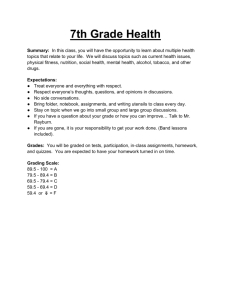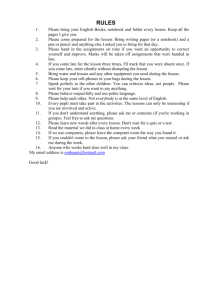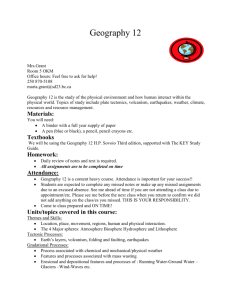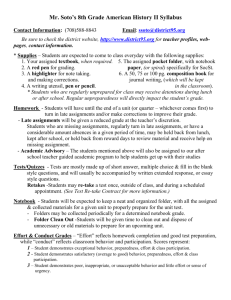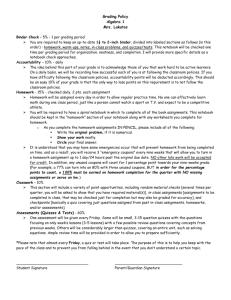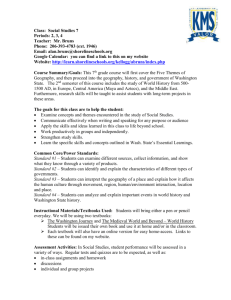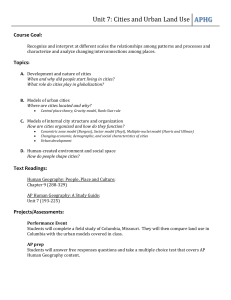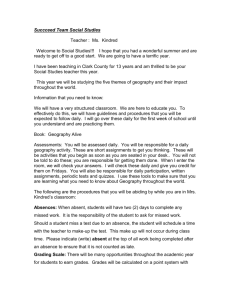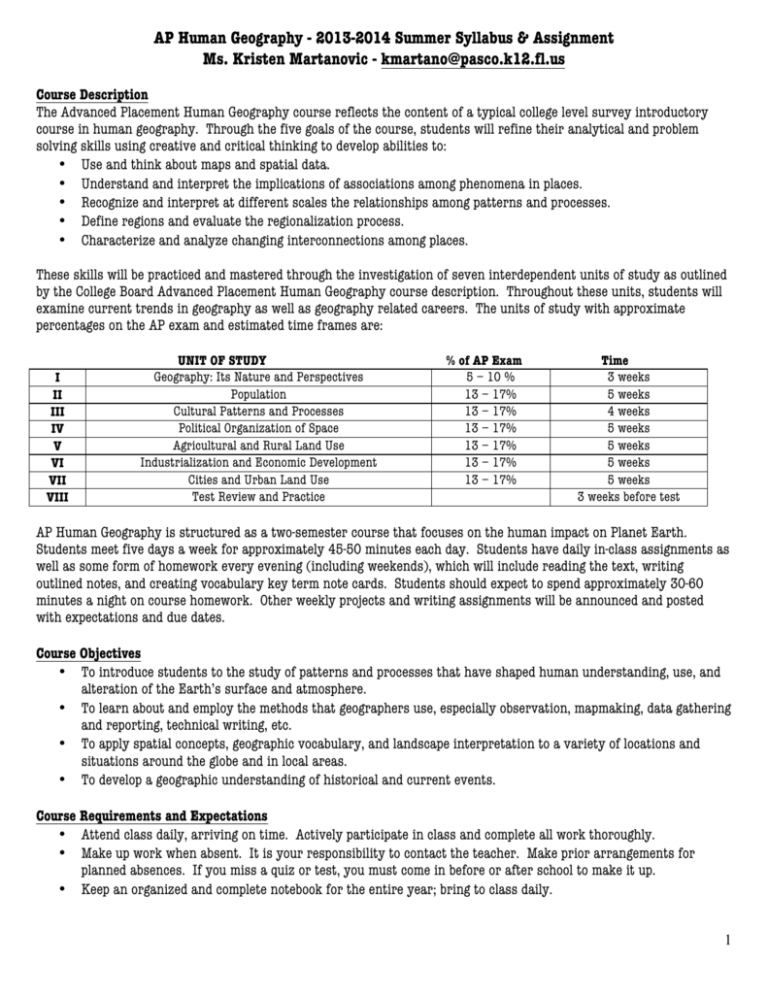
AP Human Geography - 2013-2014 Summer Syllabus & Assignment
Ms. Kristen Martanovic - kmartano@pasco.k12.fl.us
Course Description
The Advanced Placement Human Geography course reflects the content of a typical college level survey introductory
course in human geography. Through the five goals of the course, students will refine their analytical and problem
solving skills using creative and critical thinking to develop abilities to:
• Use and think about maps and spatial data.
• Understand and interpret the implications of associations among phenomena in places.
• Recognize and interpret at different scales the relationships among patterns and processes.
• Define regions and evaluate the regionalization process.
• Characterize and analyze changing interconnections among places.
These skills will be practiced and mastered through the investigation of seven interdependent units of study as outlined
by the College Board Advanced Placement Human Geography course description. Throughout these units, students will
examine current trends in geography as well as geography related careers. The units of study with approximate
percentages on the AP exam and estimated time frames are:
I
II
III
IV
V
VI
VII
VIII
UNIT OF STUDY
Geography: Its Nature and Perspectives
Population
Cultural Patterns and Processes
Political Organization of Space
Agricultural and Rural Land Use
Industrialization and Economic Development
Cities and Urban Land Use
Test Review and Practice
% of AP Exam
5 – 10 %
13 – 17%
13 – 17%
13 – 17%
13 – 17%
13 – 17%
13 – 17%
Time
3 weeks
5 weeks
4 weeks
5 weeks
5 weeks
5 weeks
5 weeks
3 weeks before test
AP Human Geography is structured as a two-semester course that focuses on the human impact on Planet Earth.
Students meet five days a week for approximately 45-50 minutes each day. Students have daily in-class assignments as
well as some form of homework every evening (including weekends), which will include reading the text, writing
outlined notes, and creating vocabulary key term note cards. Students should expect to spend approximately 30-60
minutes a night on course homework. Other weekly projects and writing assignments will be announced and posted
with expectations and due dates.
Course Objectives
• To introduce students to the study of patterns and processes that have shaped human understanding, use, and
alteration of the Earth’s surface and atmosphere.
• To learn about and employ the methods that geographers use, especially observation, mapmaking, data gathering
and reporting, technical writing, etc.
• To apply spatial concepts, geographic vocabulary, and landscape interpretation to a variety of locations and
situations around the globe and in local areas.
• To develop a geographic understanding of historical and current events.
Course Requirements and Expectations
• Attend class daily, arriving on time. Actively participate in class and complete all work thoroughly.
• Make up work when absent. It is your responsibility to contact the teacher. Make prior arrangements for
planned absences. If you miss a quiz or test, you must come in before or after school to make it up.
• Keep an organized and complete notebook for the entire year; bring to class daily.
1
•
•
•
•
•
•
•
Use charts, maps, lecture, and reading notes kept in your notebooks to study for tests. Ask for help if your
notebook is incomplete.
If possible, form a study group for tests and use study aids such as flash cards to help you master the
vocabulary you will encounter on specific assignments.
Ask the teacher for help if needed – I am committed to supporting your efforts!
Challenge yourself to work hard and maintain high standards.
Take advantage of opportunities to redo work for mastery of the course content and skills of the course.
Attend review sessions offered in spring semester before the exam on Tuesday, May 13, 2014.
Attend practice test sessions offered in spring semester before the exam on Tuesday, May 13, 2014.
Primary Textbook
Rubenstein, James M. An Introduction to Human Geography. 10th ed. New Jersey: Pearson Prentice Hall, 2011.
***During the first week of school, each student will be given an access code to register and utilize the online textbook for the
school year. There will be a class set of textbooks but there are no extra copies that can be taken home. Textbooks may be
purchased online at various websites (Amazon, etc.) if students wish to highlight, underline, etc. in their personal book. This
is an OPTIONAL purchase only!***
Grading
As this is a college level course, there will be no extra credit assignments to substitute for required course work.
Grading Scale
o 90 – 100: A
o 80 – 89: B
o 70 – 79: C
o 60 – 69: D
o 0 – 59: F
Grading Policy
The grading distribution is split up into five categories:
1. Tests (100 points each) – Students will be given exams one to two times a quarter to measure their levels of mastery of each
chapter covered in class. Tests will be structured in the AP format – with a timed section of multiple-choice questions and timed
constructed response questions.
2. Quizzes (25 - 50 points each) – Content and vocabulary quizzes will be administered throughout the course. Please note that
quizzes may contain material that was covered previously in an effort to recall important information that may be on the course
exam. Although most quizzes will be announced, there will be occasional pop-quizzes.
* NOTE: Students will be given the opportunity to rework incorrect responses on quizzes and submit them for points added onto
their original test or quiz grades (based upon teacher discretion).
3. Unit Projects or Written Reports (points vary) – Students will be responsible for completing many written assignments
throughout the course as well as several projects.
4. Classwork and Homework (points vary) – Students are given classwork assignments each day and homework assignments for
each night of the week, including weekends. Assignments may include, but are not limited to, map work, timelines, assigned
readings, chapter outlines, vocabulary identification chards, guided reading questions, debates, seminars, projects, simulations, and
research papers using the MLA style.
5. Notebook Check (points vary) – Notebook checks will be given after each unit is completed to make sure students are well
organized, taking notes, and saving their class work.
***A detailed syllabus will be given to all AP HuG students at AP Boot Camp (Thursday, August 9, 2013). On the first day of
school, students will receive a calendar, letter from the teacher, and an academic agreement which BOTH student and parent /
guardian must sign and return the following school day.***
2
AP Human Geography - Summer 2013 Assignments
Ms. Kristen Martanovic - kmartano@pasco.k12.fl.us
Course Supplies
The following supplies must be purchased and brought to AP Boot Camp on Thursday, August 8, 2013
(1) 3 ring binder – 1” thick for AP Human Geography use ONLY (will remain in classroom)
Page savers (1 pack / 15-20, will remain in classroom in binder)
(1) 5 subject spiral notebook WITH pockets (MUST BE at least 8½ x 11”. Mead Five Star is STRONGLY
recommended due to its size and durability.)
(1) 2 pocket folder with prongs and pockets
Set of 10 dividers (1 pack of 10 or 2 packs of 5)
Blue or black pen
#2 Pencil
Glue stick
$15 cash or money order (NO CHECKS) for AP test-prep book which will be handed out the first month of
school (money can also be turned in the first week of school)
The following supplies must be purchased and should be readily available in student’s backpack and/or locker
#2 pencils
Blue or black pen
Red pen
Highlighters (must have yellow AND at least one other color)
Set of 12-24 colored pencils
Pack of 8 markers
Glue stick
Notebook paper (college or wide-ruled)
1 pack of note cards (3x5 or 4x6; depends on size of student’s handwriting)
1 pack of Post-it notes
The following supplies must be purchased and kept at home for future use
4-5 packs of note cards (3x5 or 4x6; depends on size of student’s handwriting)
Container to keep note cards in a safe place (notecards are consistently being used throughout the entire
school year)
Glue sticks
WISH LIST
The following items are used to ensure a safe, clean, and effective learning environment. Any contributions are
greatly appreciated:
- Ream of computer paper (white or lightly colored)
- Tissues
- Paper Towels
- Cleaning wipes
- Hand Sanitizer
3
Summer Assignment #1
Having a working knowledge of specific countries will help your understanding of this course. This assignment
requires you to create a country profile for 4 countries in which 1 country MUST be the United States. Please pick 3
countries that intrigue you and that you would be interested in researching further and becoming an expert on the
particular country. It is imperative that all work completed on a computer needs to be saved!! You will be using this
information again throughout the school year. Below is the list of countries you may choose from.
AFRICA
1. Angola
2. Benin
3. Burkina Faso
4. Burundi
5. Central African Republic
6. Chad
7. Comoros
8. Democratic Republic of the Congo
9. Djibouti
10. Equatorial Guinea
11. Eritrea
12. Ethiopia
13. Gambia
14. Guinea
15. Guinea-Bissau
16. Lesotho
17. Liberia
18. Madagascar
19. Malawi
20. Mali
21. Mauritania
22. Mozambique
23. Niger
24. Rwanda
25. São Tomé and Príncipe
26. Senegal
27. Sierra Leone
28. Somalia
29. South Sudan
30. Sudan
31. Togo
32. Uganda
33. United Republic of Tanzania
34. Zambia
LATIN AMERICA & THE CARIBBEAN
35. Haiti
ASIA
36. Afghanistan
37. Bangladesh
38. Bhutan
39. Cambodia
40. Kiribati
41. Lao People’s Democratic Republic
42. Myanmar
43. Nepal
44. Samoa
45. Solomon Islands
46. Timor-Leste
47. Tuvalu
48. Vanuatu
49. Yemen
Because this will be a working document all school year, simply paper-clipping all required documents together will
be sufficient for this assignment. The first page will be a cover page consisting of your name and the name of the 3
countries you chose AND the United States. After the cover page, you will have a world map. Please print and use
the world map that is provided on Edmodo. On this map, label and color in your countries, including the United
States.
The third portion of this assignment is the country profile (demographics chart). This can be found on Edmodo.
This is a template document and you can type directly in the boxes or print out and print your answers. If you
4
choose to type in the boxes, please remember to print it out and include it in your assignment. The following two
websites will help you find the information you need:
o CIA – the World Factbook https://www.cia.gov/library/publications/the-world-factbook/
Click on “select a country or region”.
Find your country and click on it.
Learn about your country and complete the chart.
o PRB – Population Reference Bureau http://www.prb.org/
Click on the tab, “Data Finder”
Under Profiles, click Countries, which is below International.
Choose your country and click.
Click on the orange box that is next to your country’s name, “change locations/indicators”.
Under Indicators, click all of the topics: Highlights, Demographics, Economic, Education,
Environment, Health, HIV/AIDS, and Reproductive Health.
Click on Continue.
Learn about your country and complete the chart.
o All answers should be located within these two resources. If not, please use a reliable source and indicate
which source you used at the end of your country profile.
The final items in your country profile will be 3 news articles pertaining to your countries (INCLUDING the United
States). These articles should demonstrate the IMPORTANCE OF GEOGRAPHY to your country's development.
Possible topics to focus on are: agriculture, natural resources, economics, disputes with other countries, culture,
migration, refugees, natural disasters, population, etc. Your articles should cover a variety of topics and should be
spread out over the summer. Each article must be printed out or cut out of a newspaper and include the proper
citation information (publication, date, pages, etc.) This information will be placed at the bottom of your summary.
Summaries can be typed or handwritten. Please remember to write the name of the country the article is
referencing at the top of the summary. There should be a total of 12 articles and 12 summaries.
o Worthy sources for articles include the following but are not limited to:
• The New York Times – www.nytimes.com
• International Herald Tribune - www.iht.com
• CNN – www.cnn.com
• BBC World News - http://news.bbc.co.uk
• Washington Post – www.washingtonpost.com
• Foreign Policy Magazine – www.foreignpolicy.com
• Other reputable news sources
*** Encyclopedia articles, blogs, and editorials are NOT acceptable***
This assignment is due the first day of school – Monday, August 19, 2013!
Summer Assignment #3
Be curious about the world—not just your immediate world, but also the whole world. Start watching the news and
reading the national and international section of major newspapers. Make it a point to learn about what is going on
in the world and discuss it with your family or friends.
***Questions?? Email Ms. Martanovic - kmartano@pasco.k12.fl.us or send me a message on Edmodo***
5

